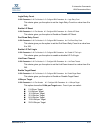
3–Interactive Commands
HBA Parameters Menu
SN0054614-00 K 3-35
Priority Flow Control enables you to manage pauses in traffic according to
assigned priorities to class of service (CoS) frames; that is, on per-flow basis. CoS
is a way of managing traffic in a network by grouping similar types of traffic (for
example, e-mail, streaming video, voice, large document file transfer) together
and treating each type as a class with its own level of service priority.
Priority Flow Control applies to servers with a single adapter interface, which
could carry traffic for LAN, SAN, and IPC. In this case, SAN traffic is marked with
a specific CoS to identify it as a distinct flow among other flows (LAN, IPC), and
pause can be applied to this specific CoS to assure lossless SAN frames. When
connected to a DCBX-enabled peer, the pause type is automatically set with
priority flow control (per-priority pause) when the peer sends a priority flow control
time length value, regardless of this parameter setting.
The pause type will be reconfigured based on the setting of this parameter
whenever the following occurs:
The network link goes down.
The system is reset.
DCBX: When connected to a data center bridging exchange protocol (DCBX)
enabled peer, the pause type is automatically configured to be Priority Flow
Control (per-priority pause) when the peer sends a Priority Flow Control
type-length-value (TLV), this parameter is configured on the adapter. When not
connected to a DCBX-enabled peer, or before receipt of a Priority Flow Control
TLV, on setting of this parameter on the adapter.
FCoE COS
3: HBA Parameters N: FCoE Engine 2: Configure FCoE Parameters n. FCoE COS
This option prompts you to configure a persistent value for the FCoE class of
service (CoS) for priority encoded FCoE packets. Type a numeric value in the
range of 0 through 7, and then press
ENTER
. The current value is indicated in
brackets; the default value is 3.
FCoE packets must carry a CoS value and must be tagged, meaning that the port
must be configured as a trunk port. This setting affects the connection when
connected to a peer with DCBX protocol and a matching CoS setting. If the DCBX
peer CoS setting does not match, the connection is not affected by this setting.
When not connected to a DCBX-enabled peer, or before receiving an FCoE CoS
value, the FCoE CoS type length value is based on this parameter setting. In this
case, the FCoE packets will only be priority encoded if the network port is
configured as a trunk port (see “Port Type” on page 3-34).
When connected to a DCBX-enabled peer, the FCoE CoS value is automatically
set to value specified in the FCoE CoS type length value, regardless of this
parameter setting. When connected to a switch that supports DCBX (for example,
the Cisco Nexus™ 5020 switch), the port type is implicitly changed by FCoE
engine firmware to be a trunk port, regardless of the persistent settings.


















